The Human Genome Project was the most important biomedical research project of the 20th century. In many ways, it challenged some of the fundamental understandings of scientific inquiry that had stood for centuries. The completion of the project in 2003 and subsequent boom in the genomics field has had a profound impact not just on biology and medicine but also on ethics and society. The project also changed traditional understandings of how and why scientific research is conducted.
It was, however, not without its detractors.
“The human genome project: mediocre science, terrible science policy”
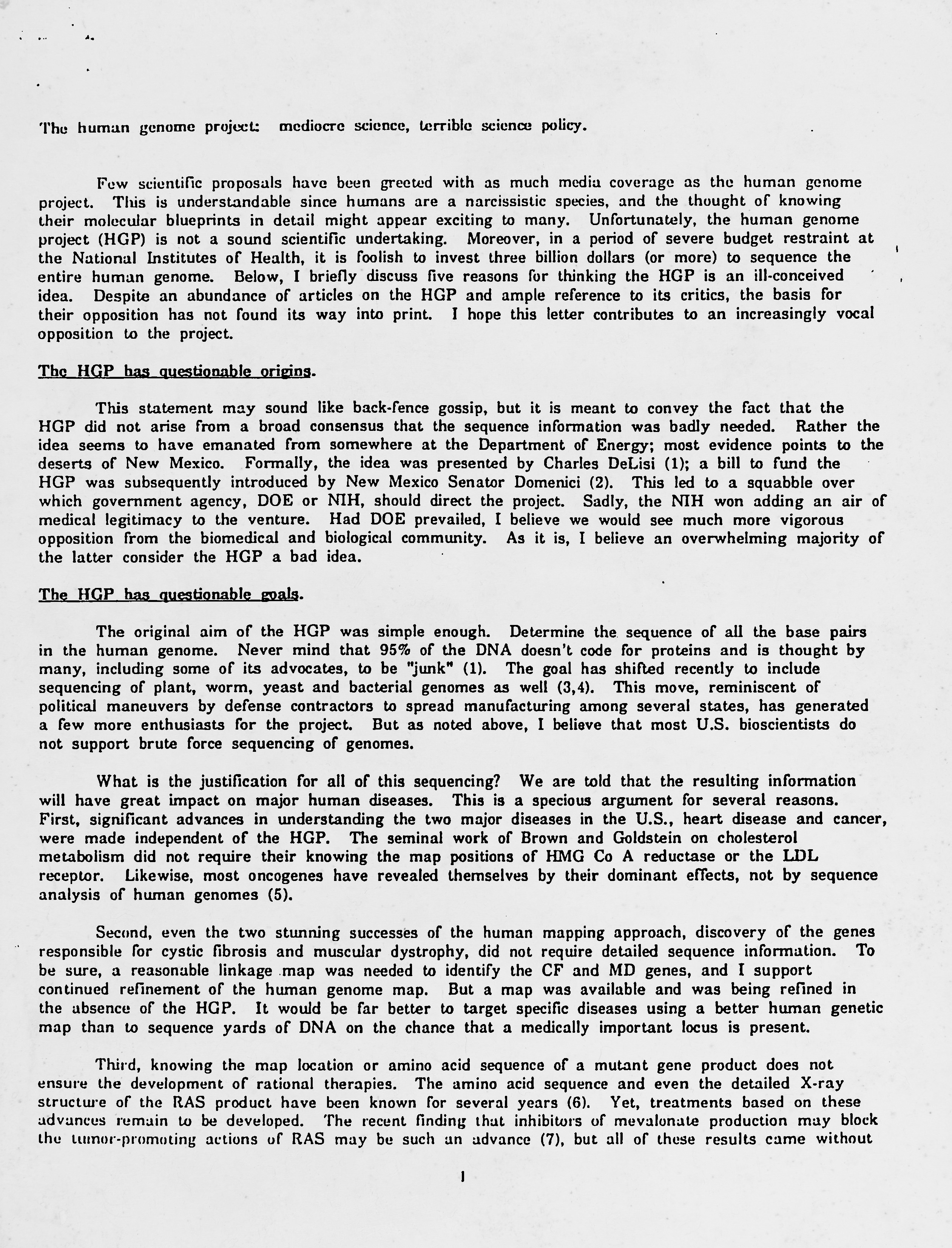
Caption: A copy of the first page of Martin Rechsteiner’s letter, which circulated and spurred the anti-Human Genome Project letter campaign. The first line of the letter reads “The human genome project: mediocre science, terrible science policy.”
Download Martin Rechsteiner's Letter (PDF)"... most of the sequencing work will not be creative or innovative ..."
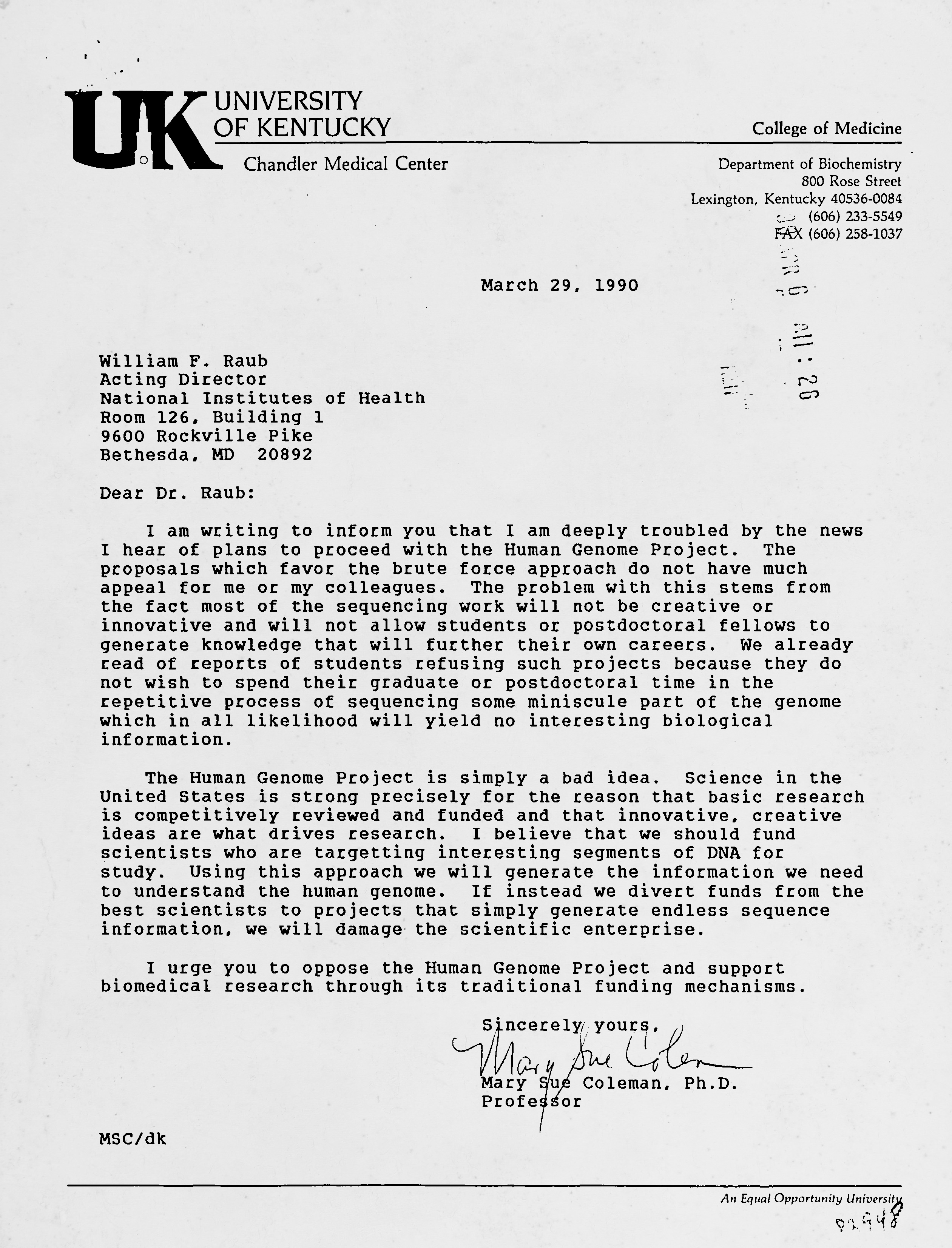
Caption: A copy of a letter sent from a University of Kentucky professor, Mary Sue Coleman, Ph.D., addressed to William Raub, Ph.D., the acting director of the NIH at the time. The above header is taken from a line in the letter: “The problem with this stems from the fact most of the sequencing work will not be creative or innovative and will not allow students of postdoctoral fellows to generate knowledge that will further their own careers.”
Mary Sue Coleman, Ph.D., a professor of biochemistry at the University of Kentucky Medical Center, argued that the Human Genome Project would not draw new professionals in science and medicine towards the field of genomics. Their argument stemmed from a belief, shared by many of the letter writers, that the majority of the work would be a merely technical and repetitive exercise, akin to pumping out endless lines of letters with “no interesting biological information.” According to the Coleman, the project “wouldn’t have much appeal for me or my colleagues.”
While it’s true that much of the work on the Human Genome Project was repetitive, the project interested and attracted more than just technicians. One of the most important legacies of the Human Genome Project is the role that interdisciplinary team science played in achieving the end goal. The Human Genome Project brought together a diverse cohort of professionals from both the private and public sector. This included not only biologists, geneticists and medical professionals, but also computer engineers, bioethicists, legal experts, mathematicians, statisticians and many others.
Many of the grantees of the Human Genome Project went on to do pathbreaking work in a diverse range of fields after the conclusion of the project. An important legacy of the Human Genome Project is to help legitimize large interdisciplinary team science.
"... Junk as far as we can tell ..."
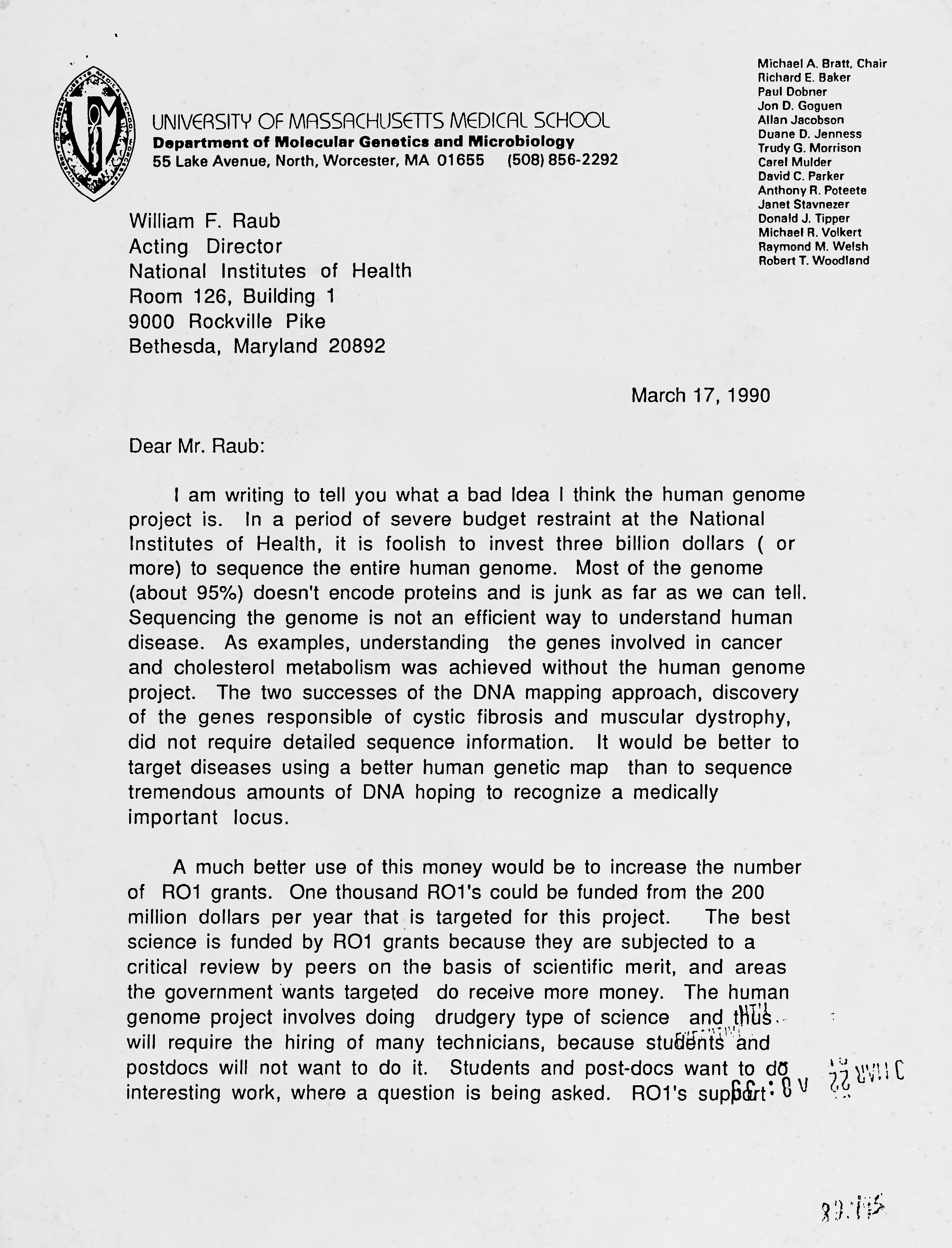
Caption: A letter from Associate Professor Janet Stavnezer, Ph.D., of the University of Massachusetts Medical School, sent to William Raub, Ph.D. The header is taken from the sentence: “Most of the genome (about 95%) doesn’t encode proteins and is junk as far as we can tell.”
A letter from Janet Stavnezer, Associate Professor at the University of Massachusetts Medical School, argued that sequencing the entire human genome wasn’t worth it because the majority of the genome was so-called “junk DNA.”
“Junk DNA” was a term that was widely used prior, during and after the Human Genome Project, including those who participated in and contributed to the project. The term describes portions of the genome that seemingly had no purpose as they didn’t code for proteins. Therefore, according to some, spending billions of dollars sequencing the genome, knowing already that most of it was “filler,” would be a waste of time and money.
Today, it remains a fact that an incredibly small percentage of the genome, only 2%, actually codes for proteins. After the Human Genome Project, however, our understanding of “junk DNA” has changed significantly. First, the scientific community retired this term and instead refer to these sections as “non-coding DNA.” We now know that some of these regions of the genome do indeed provide valuable functions in gene expression, among other things. There are still many non-coding regions of the genome whose functions are still unknown and that are being actively investigated today.
For more information on what we now refer to as “non-coding DNA,” please visit our Talking Glossary of Genomic and Genetic Terms.
Dr. Stavnezer recently commented to us about how her perception of the Human Genome Project has changed in the years since its completion: “The [Human] genome project has been very informative and has generated large amounts of data and has greatly increased our understanding of our and other species’ genomes. It has been a most important and wonderful project, and the scientists who foresaw that and made it happen have truly made a great contribution.”
Download Janet Stavnezer's Letter (PDF)"The 'Big Science Project' "
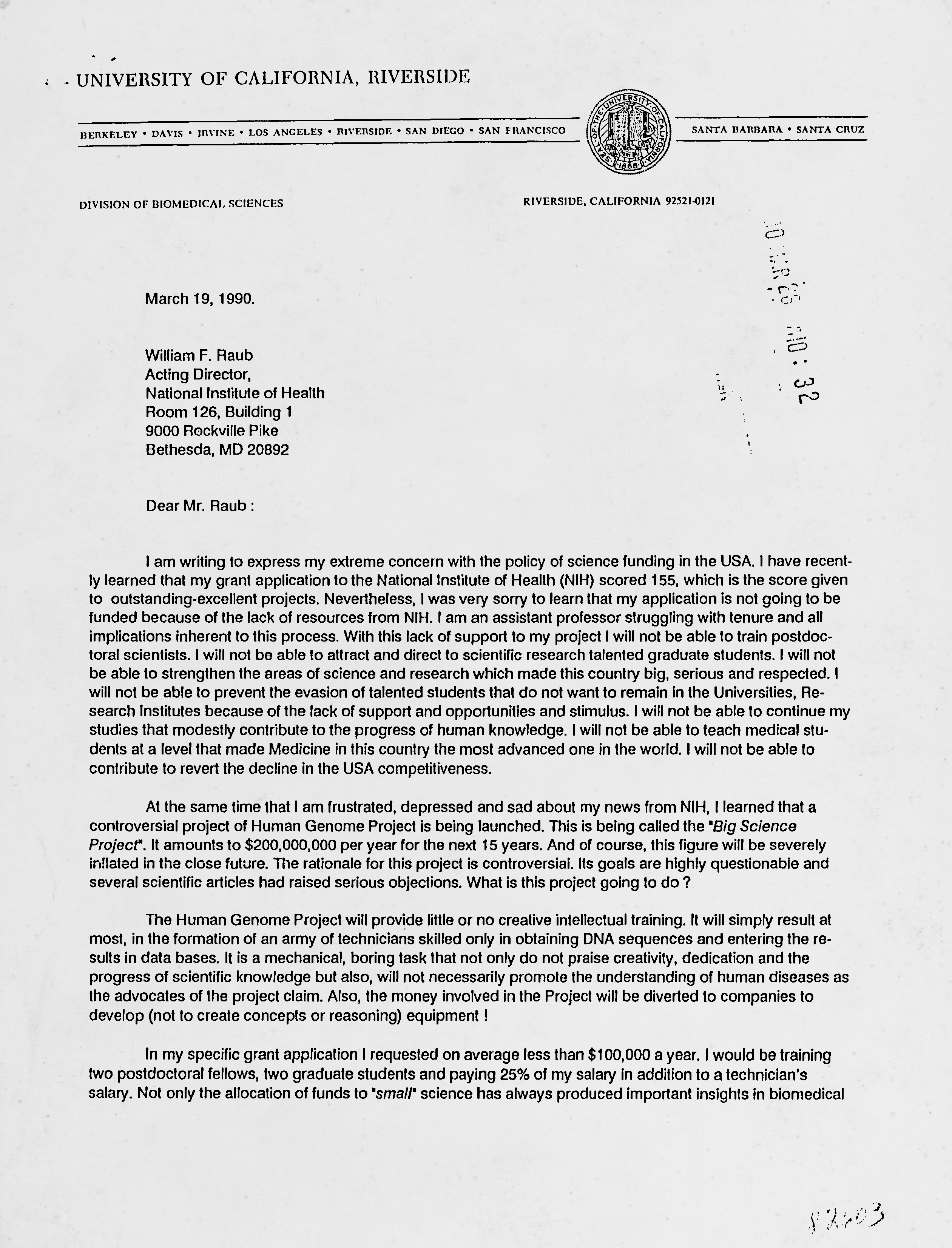
Caption: A letter from Samuel Cukierman, M.D., Ph.D., a professor in the Department of Biomedical Sciences at the University of California, Riverside. The header above the image comes from the sentence: “This is being called the ‘Big Science’ Project.”
Professor Samuel Cukeirman, M.D., Ph.D., from the University of California, Riverside’s Division of Biomedical Science, argued in their letter that the Human Genome Project, being an example of so-called “Big Science,” was both ineffective and “controversial.”
“Big Science” is a term used, often pejoratively, to describe a large-scale, centralized scientific project usually funded by a government or large bureaucratic entity. This is in contrast to what can be called “small science,” or inquiry driven by individual investigators, which is done in smaller labs with a small staff led by a principal investigator.
Historically, “big science” projects were viewed by many scientists as wasteful and inefficient. They argued that the most fruitful scientific research required a more independent and focused approach driven by a hypothesis, or central question. The Human Genome Project, by contrast, had no driving question but was motivated by a desire to explore an unknown part of the biological world.
Even Bruce Alberts, Ph.D., who would eventually serve on the Program Advisory Committee on the Human Genome Project, was outspoken in his criticisms of “big science” projects, even though he strongly supported the project. In the rebuttal letter that Dr. Jordan sent to each of the letter writers, she pointed this fact out in defense of the project.
Although the Human Genome Project bore many of the hallmarks of a “big science” project, the majority of the work of sequencing the genome was performed by individual labs that were funded largely by individual P01 and R01 grants.
Download Samuel Cuckierman's Letter (PDF)"Flagrant Waste of Federal Research Funds"
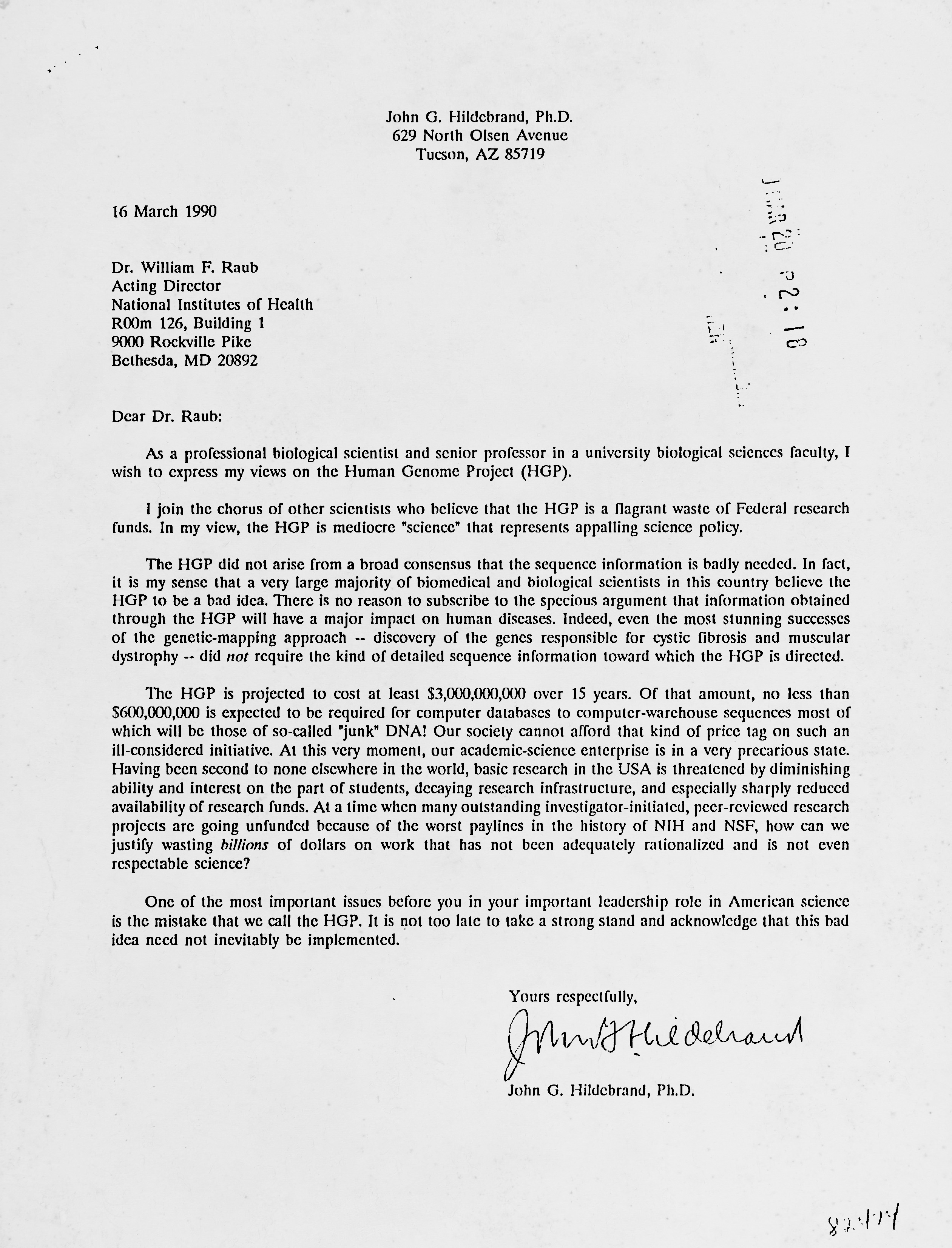
Caption: A letter from a professor of neurobiology, John D. Hildebrand, from the University of Arizona. The header is taken from the sentence “I join the chorus of other scientists who believe that the Human Genome Project is a flagrant waste of Federal research funds.”
In all of the letters written opposing the Human Genome Project, the one argument made by everyone was the objection to the overall cost of the project. At the time, the projected cost was $3 billion and it was slated to take 15 years to complete.
John Hildebrand, Ph.D., at University of Arizona, wrote “[o]ur society cannot afford that kind of price tag on such an ill-considered initiative.” Many of the letter writers further argued that this money would be much better spent on funding smaller investigator-initiated projects.
While the total cost of the Human Genome Project is difficult to determine, most agree that its final price tag was close to the original estimate of $3 billion. It was, however, accomplished in a shorter timeframe, with the final draft sequence completed and announced in 2003, two years ahead of schedule.
The Human Genome Project certainly was an expensive endeavor. However, it’s important to provide some historical context when considering the cost and value. For example, one of the most important legacies of the project is the data sharing policy (as outlined in the Bermuda Principles) of the genomic information generated. This kind of policy was made possible by the fact that the project was funded by the public. Researchers around the globe have been able to freely access this information to advance new pharmaceuticals and generate new technologies.
Additionally, a significant part of the budget was allocated to understanding the ethical and legal consequences of having human genomic information available to researchers. The Ethical, Social and Legal Implications (ELSI) Research Program was a congressionally mandated part of the Human Genome Project budget and continues to be today.
Download John Hildebrand's Letter (PDF)"A Much More Sensible Beginning"
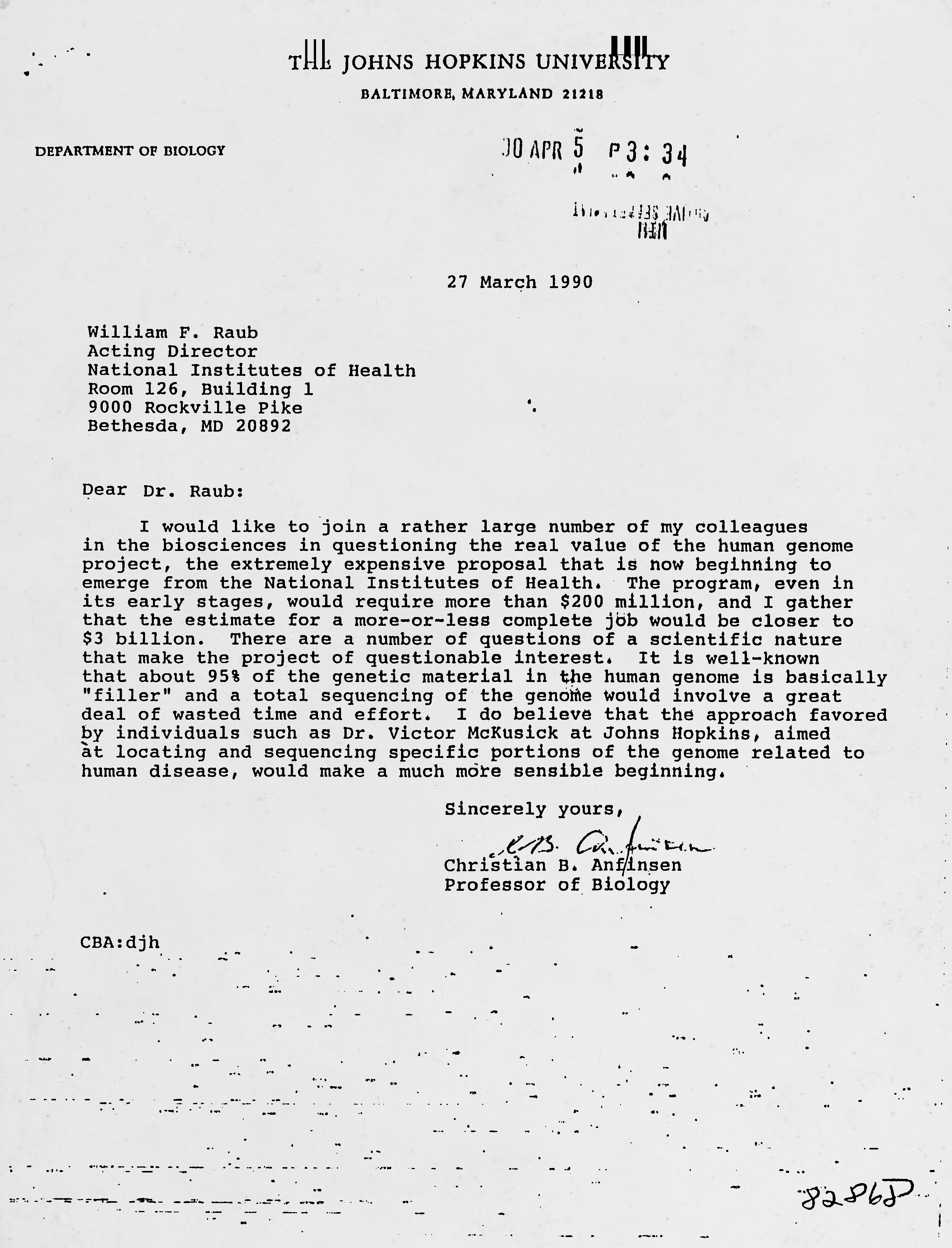
Caption: A letter from a Nobel Laureate and Professor of biology, Christian Anfinsen, Ph.D., from Johns Hopkins University. The header comes from the sentence “I do believe that the approach favored by individuals such as Dr. McKusick at Johns Hopkins University, aimed at locating and sequencing specific portions of the genome related to human disease, would make a much more sensible beginning.”
A number of letters made an argument that highlighted a division amongst genomicists and the focus of the genomics field that existed at the time, and to some extent still does. They argued that a more practical, and ultimately beneficial, approach to genome sequencing and mapping would be a more “targeted” approach. This targeted approach would seek to improve the existing genetic linkage by focusing on sequencing what one critic of the project called “medically important loc[i]” in the genome. They argued that this approach would yield more health benefits than sequencing the entire genome.
This was the type of approach that had led to researchers identifying specific genes for single-gene disorders such as cystic fibrosis and muscular dystrophy. There were many researchers in the field who believed that this approach was the best path forward. For example, a letter from Johns Hopkins University professor of biology and Nobel Laureate in chemistry, Christian B. Anfinsen cited the work of his colleague Dr. Victor McKusick, as a “more sensible beginning” for genome sequencing.
Today, these two approaches exist more harmoniously as both genomics and genetics continues to become more integrated in everyday human health care. The cost of genomic sequencing in the decades following the Human Genome Project has plummeted to a point where in the near future it will be possible for anyone to sequence their entire genome for an infinitesimally small amount compared to the cost of the Human Genome Project. The knowledge and information generated by the project has significantly improved our understanding of our genomes and genetic diseases in all of its complexity.
Download Christian Anfinsen's Letter (PDF)Last updated: May 6, 2024

